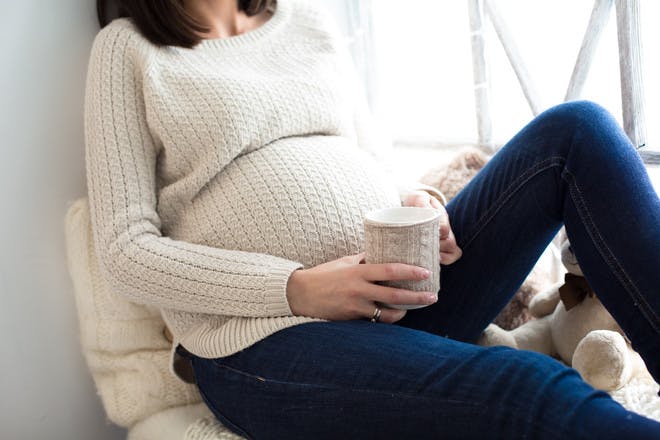You're officially halfway through your pregnancy! Here's what to expect now you've reached 20 weeks and are speeding through your second trimester.
This page contains affiliate links, which means we may earn a small amount of money if a reader clicks through and makes a purchase. All our articles and reviews are written independently by the Netmums editorial team.
What's happening at 20 weeks?
Here are the key things you can expect from your pregnancy at this halfway stage:
- Was that a growth spurt? Your baby is now measured from crown to heel, instead of crown to rump.
- You may find out the sex of your baby at your anomaly scan , if you've not already had it.
- Your back may start causing some aches and pains.
- Your bump should expand 1cm a week from now on.
How big is your baby?
Your baby is now around as long as a pack of Digestives biscuits, measuring about 25.6cm in length and weighing about 300g.
Does that seem like a big jump from last week? Until now, your growing baby was probably measured from crown to rump (head to bottom). This is because, in the first half of pregnancy, babies are curled up tightly in the womb, and it's very hard to tell how long they are when they stretch out.
FREE NEWBORN NAPPIES
But from about week 20, babies are generally a bit less curled up, making it easier to measure them from head to heel and get a true sense of how big they are.
Your baby is swallowing more this week, which is good practice for the developing digestive system. It can also set off a bout of hiccups – and this time you might even be able to feel them!
Your baby will absorb the liquid they swallow, but some of what they take in will move into the bowel as 'meconium', a sticky, dark waste product that forms the first poo after your baby's born (although sometimes babies can do them during labour).
What's going on with your body?
What's amazing is that from around now, your bump will measure about the same in centimetres as the number of weeks pregnant you are.
So, when your midwife measures you from the top of your pubic bone to the top of your bump (which she should do at every appointment as part of your regular care), it should measure around 20cm this week. It's perfectly normal for it to be a centimetre or two out, though.
If you're measuring more than 2cm smaller or bigger than expected, your midwife may refer you for a growth scan just to check everything's OK. There are lots of things that can cause a bump to appear larger or smaller than normal, including the amount of amniotic fluid and the woman's body shape, so try not to worry.
If your baby turns out to be much smaller than expected , you should be offered extra care, such as additional scans to check on their growth throughout your pregnancy. In some cases, very small babies need to be born earlier.
If your baby turns out to be much larger than expected , this isn't usually a concern. However, you may be offered testing for gestational diabetes earlier than usual.
From around now, your bump should expand by about 1cm each week until you have the baby. Clever, eh?
As this happens, it'll also cause your centre of gravity to shift, so don’t be surprised if you feel a little wobbly or clumsy these days. It might help to switch from heels to flats so you're a little steadier on your feet.
If you haven't had your anomaly scan , it'll probably happen this week. Check back to week 18 for more details of what to expect during your ultrasound scan. It could be the exciting moment where you find out your baby's sex for the first time!
What to expect this week: back pain
Your ovaries are releasing a hormone called relaxin, which relaxes ligaments and joints in your body in preparation for birth. The downside is this, coupled with your altered centre of gravity, can increase the risk of you getting backache.
To prevent the pain, it's recommended that all pregnant women pay careful attention to their posture .
Stand up straight when you walk, so your hips and shoulders stay lined up. When standing, imagine a straight line running from your ears down through your shoulders, hips and knees.
When sitting, choose a chair with good back and arm support. Try not to slouch (tilt your pelvis forwards to stop your back from arching), and keep your feet on the floor.
If your job involves standing a lot, ask your employer if you can have a chair or stool so you can rest from time to time. You may even be able to ask for different duties now that you're pregnant. Your employer has a duty to do a full health and safety check and adjust your duties accordingly.
Try these tips to ease an aching back in pregnancy …
- Sleep on your side in bed, with pillows supporting your bump and between your knees: this will take the strain off your lower back.
- Order a pregnancy bump support: this is a wide, firm, elasticated belt that supports your lower back as well as carrying some of the weight of your bump.
- Try to take some gentle exercise such as swimming or specialised antenatal aquaerobics or yoga. Building up your back muscles will not only make pregnancy easier; you'll also find it easier to lift and carry your baby after the birth.
An unlucky few women suffer from a really debilitating condition of pregnancy backache or pelvic pain called Pelvic Girdle Pain (PGP) also commonly known as Symphysis Pubis Dysfunction (SPD). This is where a joint at the front of your pelvis, which widens in pregnancy, can separate and cause intense pain.
You may feel the pain of PGP at the front of your pubic bone or in your lower back, and it can also spread to the thighs. It can also affect the vagina (pregnant women in the Netmums forum sometimes refer to this as 'fanny daggers').
The pain can be worse when walking, especially on stairs, or when you stand on one leg, turn over in bed, or move your legs apart. You may also feel or hear a clicking sound when you walk.
Try to keep active, but avoid activities that make the pain worse, and rest when you need to.
If you're finding it hard to move around due to pelvic or back pain, do speak to a doctor or midwife. You may be offered physiotherapy, which can help to relieve the symptoms for many women.
What to do this week: go shopping
Your bump has most likely well and truly popped out by now, so it’s a good time to get a few new clothes that will feel more comfortable and look good, too.
Don't worry about spending too much. All you actually need is a few key staples to look and feel good for the rest of your pregnancy.
Here are some top shopping tips to keep in mind when you hit the shops for a capsule pregnancy wardrobe :
Tap up friends for hand-me-downs: Preferably the really stylish ones that spent a fortune in pricier maternity stores like Seraphine and Isabella Oliver. If you've got your eye on some designer pregnancy denims or a maternity dress for a wedding that you'll never wear again, try eBay for second-hand bargains.
Shop online: TopShop, Gap, Next, H&M all have good-value, non-frumpy maternity clothes and often have a bigger selection online. So save your puffy ankles and shop from your iPad instead!
We heart tunic tops: Tunics, shirt-dresses, and any top that can be worn over leggings (choose over-the-bump leggings or under, depending on what you find the comfiest) are a godsend during pregnancy. Plus they'll make great comfy post-baby clothes, too.
Cardigans rather than jumpers : They’ll keep the chill off or can be easily slipped off when you get sweaty (which is quite often these days, isn’t it?), plus as you get bigger, they'll still fit as you can just leave them unbuttoned over your bump.
Don’t forget footwear: Your feet can get bigger during pregnancy (and not just because they swell – they can actually go up a whole size), so treat yourself to some new shoes.
If you're suffering from back or pelvic pain, it's best to ditch the heels and go for a comfy flat instead. Or how about using pregnancy as an excuse for a really comfy pair of trainers? Don't mind if we do.
You may also want to do some shopping for your baby , especially if you've just found out the sex at your anomaly scan. Beware: there are lots of baby products out there which look like genius hacks, but will actually just end up gathering dust in the cupboard after the birth.
Get the lowdown on what you really need to buy for your baby , and what you can do without. Or check out our guide to buying baby clothes .
Your 20 week to-do list
1 Go shopping – see above tips before you do!
2 Ask your midwife or GP for your MATB1 form or maternity certificate, which should be available to you around now. This provides medical evidence of your pregnancy and the baby's due date for your employer.
3 If you don't yet have an appointment for your whooping cough jab , contact your GP. You can have it any time between 16 and 32 weeks, and it's vitally important to protect your baby's health after the birth.
4 Start reading through your antenatal notes and ask any questions if there's anything you're unsure of in them.
5 Celebrate! You're halfway through your pregnancy, which is a seriously major milestone! Be kind to yourself, and take some me-time, whether it's a stroll in the country, curling up with a good book, or enjoying some pampering .
What to watch this week...
Get expert tips on what to expect at 20 weeks pregnant from our midwife.
What happens next week...
Want to know what happens when you're 21 weeks pregnant ? Or do you need to remind yourself what you read last week ? Just click on the numbers above to find out more about what to expect when you're that number of weeks pregnant.







